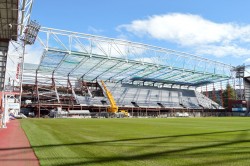With the live events industry buckling under the strain of COVID-19, a modular, factory-finished terrace product could help the sector bring reprofiling and renovation projects to a cost-effective conclusion, says David Glover, CEO, SPS Technology.
For many years traditional building materials for stadiums and arenas have been manufactured offsite before being transported to venues for installation at considerable time and expense. With an eradication of revenue from live events, social distancing and new hygiene protocols, delivering a renovation or reprofiling of a stadium or arena while the world continues to grapple with COVID-19 brings challenges of historic proportions.
For those responsible for upgrading facilities, postponing work is undoubtably an option, although for an industry that now expects to operate with squeezed margins for years to come, this is only postponing the inevitable need for work to be carried out. For those that either have to or wish to complete work as soon as possible, taking a fresh look at the building materials used to complete a project may hold the key to keeping renovation and reprofiling projects on track amid scarce resources. Critically, manufacturing a structural composite terrace system offsite before transporting it to the venue could offer a failsafe approach with a predictable schedule that saves time and is cost efficient.
For many years, reinforced concrete has been synonymous with the construction of stadiums and arenas, acting as the structural building material of choice to create spectator stands, walls, stairs, platforms etc. The components are manufactured offsite and transported to the venue for installation. While an effective process, concrete terraces are very heavy, requiring a large number of trucks for transportation at a high cost, time and carbon footprint.
Upon arrival, heavy-duty cranes are also required to manoeuvre units into position, adding further costs due to the high daily rates charged for equipment and operator. In fact, in some cases, bringing large cranes to site may be impossible, preventing improved stadium modification with concrete risers.
Lowering the weight of components by replacing reinforced concrete with structural composite plate terraces has a profound benefits for the overall steel frame of a venue, cutting its weight by 30% – with all the associated cost, time and environmental benefits that come with a lighter supporting structure. In venue renovation projects, the existing foundations can often be used. The structural composite can also be bolted on top of existing structures allowing architects to re-profile stands, with huge cost and time savings.
Terrace units arrive on site with factory applied coatings and pre-drilled holes allowing for the rapid installation of seats and attachments. New features, such as disability platforms, balconies and VIP areas can also be added with ease – while seats fitted on rails bolted direct to the structural composite can be easily adjusted, to create space between seats to maintain social distancing. At the end of an event, the same seats can be easily washed down with disinfectant, with the non-porous surface of the structural composite reducing the risk of COVID-19 and other viruses and bacteria lingering on surfaces.
Utilising structural composite in the renovation and reprofiling of stadiums and arenas is not only a short-term COVID-19 only solution. With many governments prioritising a green recovery from the pandemic, and new infrastructure projects expected to be at the fore of virus economic recovery plans, the need to re-examine the use of conventional offsite building materials in stadium and arenas construction could not be more timely – even in an inherently conservative industry.









